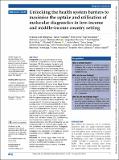Files in this item
Unlocking the health system barriers to maximise the uptake and utilisation of molecular diagnostics in low- and middle- income country setting
Item metadata
| dc.contributor.author | Ntinginya, Nyanda Elias | |
| dc.contributor.author | Kuchaka, Davis | |
| dc.contributor.author | Orina, Fred | |
| dc.contributor.author | Mwebaza, Ivan | |
| dc.contributor.author | Liyoyo, Alphonce | |
| dc.contributor.author | Miheso, Barbara | |
| dc.contributor.author | Aturinde, Augustus | |
| dc.contributor.author | Njeleka, Fred | |
| dc.contributor.author | Kiula, Kiula | |
| dc.contributor.author | Msoka, Elizabeth F | |
| dc.contributor.author | Meme, Helen | |
| dc.contributor.author | Sanga, Erica | |
| dc.contributor.author | Mwanyonga, Simeon | |
| dc.contributor.author | Olomi, Willyhelmina | |
| dc.contributor.author | Minja, Linda | |
| dc.contributor.author | Joloba, Moses | |
| dc.contributor.author | Mmbaga, Blandina Theophil | |
| dc.contributor.author | Amukoye, Evans | |
| dc.contributor.author | Gillespie, Stephen Henry | |
| dc.contributor.author | Sabiiti, Wilber | |
| dc.date.accessioned | 2021-08-25T08:30:08Z | |
| dc.date.available | 2021-08-25T08:30:08Z | |
| dc.date.issued | 2021-08-24 | |
| dc.identifier | 275152883 | |
| dc.identifier | 4923cf39-ea13-462a-a80e-9d0143c67ff4 | |
| dc.identifier | 85113745373 | |
| dc.identifier | 000688529300001 | |
| dc.identifier.citation | Ntinginya , N E , Kuchaka , D , Orina , F , Mwebaza , I , Liyoyo , A , Miheso , B , Aturinde , A , Njeleka , F , Kiula , K , Msoka , E F , Meme , H , Sanga , E , Mwanyonga , S , Olomi , W , Minja , L , Joloba , M , Mmbaga , B T , Amukoye , E , Gillespie , S H & Sabiiti , W 2021 , ' Unlocking the health system barriers to maximise the uptake and utilisation of molecular diagnostics in low- and middle- income country setting ' , BMJ Global Health , vol. 6 , no. 8 , e005357 . https://doi.org/10.1136/bmjgh-2021-005357 | en |
| dc.identifier.issn | 2059-7908 | |
| dc.identifier.other | ORCID: /0000-0001-6537-7712/work/99116014 | |
| dc.identifier.other | ORCID: /0000-0002-4742-2791/work/99116140 | |
| dc.identifier.uri | https://hdl.handle.net/10023/23830 | |
| dc.description | The study was funded by the European and Developing Countries Clinical Trials Partnership (EDCTP), grant TWENDE-EDCTP-CSA-2014-283. | en |
| dc.description.abstract | Background : Early access to diagnosis is crucial for effective management of any disease including tuberculosis (TB). We investigated the barriers and opportunities to maximise uptake and utilisation of molecular diagnostics in routine healthcare settings. Methods : Using the implementation of World Health Organisation approved TB diagnostics, Xpert MTB/RIF and Line Probe Assay (LPA) as a benchmark we evaluated the barriers and how they could be unlocked to maximise uptake and utilisation of molecular diagnostics. Results : Health officers representing 190 districts/counties participated in the survey across Kenya, Tanzania and Uganda. The survey findings were corroborated by 145 healthcare facility (HCF) audits and 11 policymaker engagement workshops. Xpert MTB/RIF coverage was 66%, falling behind microscopy and clinical diagnosis by 33% and 1% respectively. Stratified by HCF type, Xpert MTB/RIF implementation was 56%, 96% and 95% at district-, regional- and national referral- hospital levels. LPA coverage was 4%, 3% below culture across the three countries. Out of 111 HCFs with Xpert MTB/RIF, 37 (33%) utilised it to full capacity, performing ≥8 tests per day of which 51% of these were level five (zonal consultant and national referral) HCFs. Likewise, 75% of LPA was available at level five HCFs. Underutilisation of Xpert MTB/RIF and LPA was mainly attributed to inadequate- utilities, 26% and human resource, 22%. Underfinancing was the main reason underlying failure to acquire molecular diagnostics. Second to underfinancing was lack of awareness with 33% healthcare administrators and 49% practitioners were unaware of LPA as TB diagnostic. Creation of a health tax and decentralising its management was proposed by policymakers as a booster of domestic financing needed to increase access to diagnostics. Conclusion : Our findings suggest higher uptake and utilisation of molecular diagnostics at tertiary level HCFs contrary to the WHO recommendation. Country-led solutions are crucial for unlocking barriers to increase access to diagnostics. | |
| dc.format.extent | 12 | |
| dc.format.extent | 1115230 | |
| dc.language.iso | eng | |
| dc.relation.ispartof | BMJ Global Health | en |
| dc.subject | Implementaion | en |
| dc.subject | Molecular diagnostics | en |
| dc.subject | Tuberculosis | en |
| dc.subject | Maximising uptake and utilisation | en |
| dc.subject | Policy and practice | en |
| dc.subject | RA0421 Public health. Hygiene. Preventive Medicine | en |
| dc.subject | E-NDAS | en |
| dc.subject | SDG 3 - Good Health and Well-being | en |
| dc.subject.lcc | RA0421 | en |
| dc.title | Unlocking the health system barriers to maximise the uptake and utilisation of molecular diagnostics in low- and middle- income country setting | en |
| dc.type | Journal article | en |
| dc.contributor.institution | University of St Andrews. Sir James Mackenzie Institute for Early Diagnosis | en |
| dc.contributor.institution | University of St Andrews. Centre for Biophotonics | en |
| dc.contributor.institution | University of St Andrews. Infection and Global Health Division | en |
| dc.contributor.institution | University of St Andrews. Global Health Implementation Group | en |
| dc.contributor.institution | University of St Andrews. Gillespie Group | en |
| dc.contributor.institution | University of St Andrews. Biomedical Sciences Research Complex | en |
| dc.contributor.institution | University of St Andrews. School of Medicine | en |
| dc.identifier.doi | 10.1136/bmjgh-2021-005357 | |
| dc.description.status | Peer reviewed | en |
| dc.date.embargoedUntil | 2021-08-24 | |
| dc.identifier.url | https://gh.bmj.com/content/6/8/e005357.full#supplementary-materials | en |
This item appears in the following Collection(s)
Items in the St Andrews Research Repository are protected by copyright, with all rights reserved, unless otherwise indicated.

